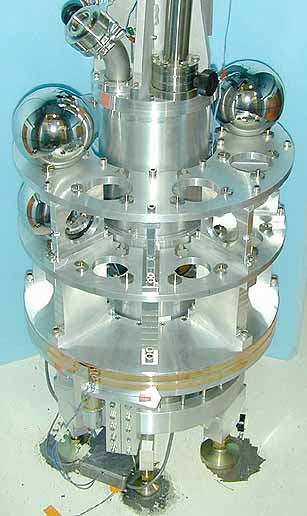
July 2000 (Volume 9, Number 7)
From Big G to Extra Dimension: Gravity Measurements Reported at APS Long Beach Meeting
 The apparatus used by the research group at the University of Washington, Seattle, to measure G to record high precision. The device, about two feet across, measures the attraction between a hanging plate (hidden inside the cylinder) and several spheres which rotate about the cylinder. Photo from http://www.aip.org/physnews/graphics/html/newgrav.html |
UW Scientists Announce Best Measurement of G
By far the most widely covered research result at the APS April Meeting was the announcement of a long-awaited higher precision measurement of the gravitational constant (affectionately known as "Big G" among physicists) by Jens Gundlach of the University of Washington. Although G has been of fundamental importance to physics and astronomy ever since it was introduced by Isaac Newton in the seventeenth century (the gravitational force between two objects equals G times the masses of the two objects and divided by their distance apart squared), it has been relatively hard to measure, owing to the weakness of gravity.
The UW group has reduced the uncertainty in the value of G by almost a factor of ten. Their preliminary value is G=6.67390 x 10-11 m3/kg/s2 with an uncertainty of 0.0014%. Combining this new value of G with measurements made with the Lageos satellite (which uses laser ranging to keep track of its orbital position to within a millimeter) permits the calculation of a brand new, highest precision mass for the earth: 5.97223 (+/- .00008) x 1024 kg. Similarly the new mass of the sun becomes 1.98843 (+/- .00003) x 1030 kg.
According to Gundlach, the setup is not unlike Cavendish's venerable torsion balance of two hundred years ago: a hanging pendulum is obliged to twist under the influence of some nearby test weights. But in the Washington experiment measurement uncertainties are greatly reduced by using a feedback mechanism to move the test weights, keeping pendulum twisting to a minimum.
Gravity at the Submillimeter Scale
Another team of scientists at the University of Washington has succeeded in measuring gravity at the submillimeter scale for the first time. The force has long been studied over planetary distances but is more difficult to gauge at the terrestrial scale, where intrusive electric and magnetic fields, many orders of magnitude stronger than gravity fields, can be overwhelming. Nevertheless, Eric Adelberger and his UW colleagues have managed to measure the force of gravity over distances as small as 150 microns using a disk-shaped pendulum carefully suspended above another disk, with a copper membrane stretched between them to help isolate electrical forces.
The subject of short-range gravity has recently attracted much theoretical and experimental interest owing to a relatively new model which supposes the existence of extra spatial dimensions in which gravity, but not other forces, might be operating. According to Nima Arkani-Hamed of LBL, this is why gravity is so weak: it dilutes itself in the extra dimensions. In other words, ordinary particles are tethered to our conventional spacetime, or "brane," while gravitons are free to roam into otherwise unseeable dimensions.
One implication of the model, testable with tabletop experiments such as Adelberger's, is that the gravitational force might depart from Newton's inverse square law (gravity inversely proportional to the square of the distance between two objects) at close range. Adelberger did not observe such a departure at distances down to tenths of a millimeter and will continue to explore even shorter distances. (For a list of tabletop experiments underway, see http://gravity.phys.psu.edu/mog/mog15/node12.html.)
Another interesting implication of the model introduced by Arkani-Hamed and collaborators two years ago is that the unification of the four known forces would not necessarily occur at energies as high as 1019 GeV but possibly at energies as low as 104 GeV, an energy scale within reach of the Large Hadron Collider under construction at CERN. Extra dimensions could, for example, manifest themselves in proton-proton collisions as an apparent disappearance of energy, implying that some of the collision energy had been converted into gravitons (the particle form of gravity) which then disappear into the extra dimensions. The gravitons produced in this way might come back into our conventional world of 3 spatial dimensions and decay into two photons.
Physicists have already looked for this kind of event. Gregory Landsberg of Brown University reported that at the D0 experiment at Fermilab some energetic two-photon events have been observed (including one in which the energy of the photons added up to 574 GeV, representing the highest composite mass ever seen in the D0 experiment) but not often enough to constitute evidence for extra dimensions. In fact this shortage of events has been translated into a lower limit of 1300 GeV for the energy at which a prospective unification of the forces could take place.
-Philip F. Schewe, AIP Public Information
©1995 - 2024, AMERICAN PHYSICAL SOCIETY
APS encourages the redistribution of the materials included in this newspaper provided that attribution to the source is noted and the materials are not truncated or changed.
Associate Editor: Jennifer Ouellette
July 2000 (Volume 9, Number 7)
Articles in this Issue
